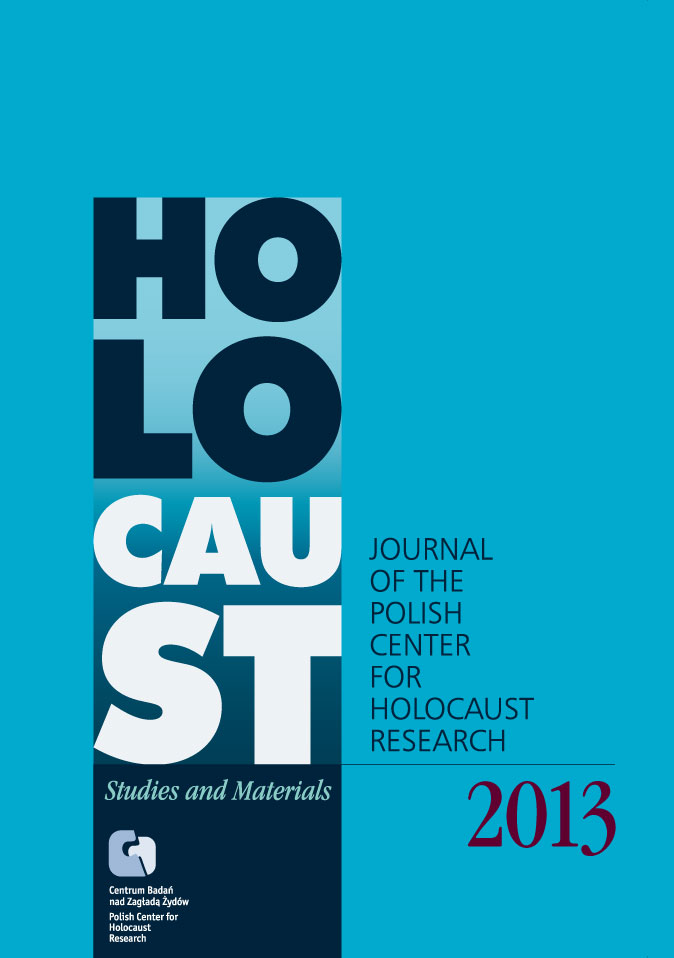Gone but not Forgotten: Archaeological approaches to the site of the former Treblinka Extermination Camp in Poland
Zagłada Żydów. Studia i Materiały, Nr Holocaust Studies and Materials (2013), Strony: 253-289
Data zgłoszenia: 2020-12-13Data publikacji: 2013-02-20
 https://doi.org/10.32927/zzsim.809
https://doi.org/10.32927/zzsim.809
Abstrakt
Public impression of the Holocaust is unquestionably centred on knowledge about, and the image of, Auschwitz-Birkenau – the gas chambers, the crematoria, the systematic and industrialized killing of victims. Conversely, knowledge of the former extermination camp at Treblinka, which stands in stark contrast in terms of the visible evidence that survives pertaining to it, is less embedded in general public consciousness. As this paper argues, the contrasting level of knowledge about Auschwitz-Birkenau and Treblinka is centred upon the belief that physical evidence of the camps only survives when it is visible and above-ground. The perception of Treblinka as having been “destroyed” by the Nazis, and the belief that the bodies of all of the victims were cremated without trace, has resulted in a lack of investigation aimed at answering questions about the extent and nature of the camp, and the locations of mass graves and cremation pits. This paper discusses the evidence that demonstrates that traces of the camp do survive. It outlines how archival research and non-invasive archaeological survey has been used to re-evaluate the physical evidence pertaining to Treblinka in a way that respects Jewish Halacha Law. As well as facilitating spatial and temporal analysis of the former extermination camp, this survey has also revealed information about the cultural memory associated with the site and how much has been forgotten about its history.
Licencja
Prawa autorskie (c) 2013 Autor&"Zagłada Żydów. Studia i Materiały"

Utwór dostępny jest na licencji Creative Commons Uznanie autorstwa 4.0 Międzynarodowe.
https://creativecommons.org/licenses/by/4.0
Czasopismo publikowane jest w standardzie Diamond Open Access na licencji CC-BY-4.0 Deed - Uznanie autorstwa 4.0 Międzynarodowa - Creative Commons
Inne teksty tego samego autora
- Caroline Sturdy Colls, O tym, co minęło, lecz nie zostało zapomniane: Badania archeologiczne na terenie byłego obozu zagłady w Treblince , Zagłada Żydów. Studia i Materiały: Nr 8 (2012)
Podobne artykuły
- Martin Dean, David Cesarani, Final Solution: The Fate of the Jews 1933–1949 , Zagłada Żydów. Studia i Materiały: Nr 13 (2017)
- Jacek Leociak, Adam Mazur, Artur Żmijewski, „Berek jest głosem o niemocy wobec okrucieństwa; pragnieniem, by Zagłada się nie wydarzyła”. Z Arturem Żmijewskim rozmawiają Jacek Leociak i Adam Mazur , Zagłada Żydów. Studia i Materiały: Nr 17 (2021)
- Janusz Salamon, SJ, Dialog chrześcijańsko-żydowski w krainie schorowanej wyobraźni. Na marginesie książki Waldemara Chrostowskiego Kościół, Żydzi, Polska , Zagłada Żydów. Studia i Materiały: Nr 5 (2009)
- Piotr Filipkowski, Pozagładowe historie mówione: nagrania, archiwa, sposoby lektury , Zagłada Żydów. Studia i Materiały: Nr 9 (2013)
- Justyna Kowalska-Leder, Fetyszyzacja autentyczności – casus muzeum-miejsca pamięci , Zagłada Żydów. Studia i Materiały: Nr 17 (2021)
- Jacek Leociak, O nadużyciach w badaniach nad doświadczeniem Zagłady , Zagłada Żydów. Studia i Materiały: Nr 6 (2010)
- Dariusz Libionka, Pierwszy zarys historii Żydowskiej Organizacji Bojowej [Icchak Cukierman, Powstanie i rozwój ŻOB] , Zagłada Żydów. Studia i Materiały: Nr 9 (2013)
- Nawojka Cieślińska-Lobkowicz, Polskie. Żydowskie. „Pożydowskie”. Nazistowska grabież dzieł sztuki i problemy restytucji w Polsce 1945–2000 , Zagłada Żydów. Studia i Materiały: Nr 16 (2020)
- Marek Hłasko, Szukając gwaizd , Zagłada Żydów. Studia i Materiały: Nr 4 (2008)
- Jacek Leociak, The Holocaust in a “Museum of life” (the Polin Museum and its trouble with the genius loci of the Muranów district) , Zagłada Żydów. Studia i Materiały: Nr Holocaust Studies and Materials (2017)
<< < 1 2 3 4 5 6 7 8 9 10 11 12 13 14 15 16 17 18 19 20 21 22 23 24 25 26 27 28 29 30 31 32 33 34 35 36 37 38 39 40 41 42 43 44 45 46 47 48 49 50 > >>
Możesz również Rozpocznij zaawansowane wyszukiwanie podobieństw dla tego artykułu.
 English
English
 Język Polski
Język Polski




